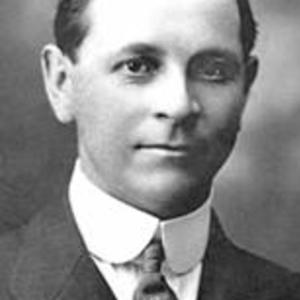
Source: Link
HOLLINGER, BENJAMIN, prospector; b. 10 April 1885 in Point Alexander, Ont., youngest son of John Hollinger, a schoolteacher, and Sarah Sutherland; m. 4 Feb. 1913 Ellen Jane Hill in Pembroke, Ont., and they had a daughter and two sons; d. there 26 Nov. 1919.
Raised in the upper Ottawa valley, Benjamin Hollinger struck out on his own at 18. He was first employed as a tool sharpener at Copper Cliff (Sudbury), and then he moved to the boom town of Cobalt in 1905. Over the next four years he prospected throughout northern Ontario for silver and placer gold, staking claims and then selling them. Although nickel had been uncovered in the Sudbury area in the 1880s and silver in Cobalt in 1903, fortunes invested in exploration had yet to yield a hardrock gold-mine. As the Toronto Globe later put it, “The north country contained more fakirs to the square inch than any one spot on earth.”
Increasingly prospectors began to turn to the more northerly areas of “New Ontario,” attracted by encouraging geological reports, the discovery of gold at Night Hawk Lake in 1907, and the extension of the Temiskaming and Northern Ontario Railway to Cochrane in 1909. On 3 Oct. 1909 Hollinger and a companion, Alex Gillies, set out to explore the region six miles west of Porcupine Lake, hoping to find surface showings. Six days later Hollinger was stripping moss from an outcrop when he discovered gold in a quartz dyke over 1,000 feet in length. An eyewitness remarked that “all through this quartz the fine particles of free gold could be seen, salt shot out of nature’s blunderbuss at short range.” Hollinger and Gillies quickly staked three claims each, and the good-natured Hollinger registered an additional claim for his friend Bernard P. McEnaney, who had been prevented from making the trip by ill health. James F. Whitson, assistant chief of provincial surveys, reported that “free gold can be seen across the dyke in many places. I never saw anything like it in Ontario before.” Such assessments sparked a rush to the region, and over 2,000 additional claims were staked in the next three months.
Not having the backing needed to develop his site, in December 1909 Hollinger signed an option to purchase with a syndicate composed of Noah Anthony Timmins*, Louis Henry Timmins*, Duncan and John McMartin, and David Alexander Dunlap. Eventually he was paid $165,000 for the property. Within a few months the syndicate had cleared 40 acres of land (the site of the town of Timmins), established a powerplant, and sunk three shafts. (The principal ore bodies were massive but low-grade and deep lying, and required heavy investment.) The Hollinger Mine became the leading gold producer in the Porcupine region and Ontario soon led all other provinces in gold shipments. In 1909, for example, only 1,569 ounces of gold were produced in the province; by 1916 the total was 492,491.
After his strike, Hollinger continued to prospect, participated in a number of other mining developments, and built a substantial home for his family in Pembroke. Although he fared well – he wisely handled his assets through a trust company – the new owners of the Hollinger property enjoyed fabulous riches. During its 57 years of operation, the mine produced some 19 million ounces of gold worth nearly $600 million, and the Porcupine camp would eventually yield more than $1,200 million in gold. The spectacular wealth produced by metal mining on the Canadian Shield made the mining industry an important component of the Ontario economy, with a strong impact on public policy [see Francis Cochrane].
Like many other individuals from the Ottawa valley at the turn of the century, Hollinger sought to earn his livelihood by exploiting the natural resources of northern Ontario. Unlike most, he struck it rich, but unfortunately he did not enjoy his modest fortune for long. At the age of 34, while having breakfast in his Pembroke home, Hollinger succumbed to heart trouble. The Porcupine Advance declared on 3 Dec. 1919 that the pioneer prospector had enjoyed a local reputation for being “pleasant, cheerful, loyal and a gentleman always.”
[Details concerning Benjamin Hollinger were drawn from the author’s interview with his son, Benjamin E. Hollinger of Pembroke, Ont., in August 1994. g.s.]
AO, F 1335-5, “History of the Hollinger mines”; RG 22-364, no.2455; RG 80-8-0-731, no.28317. DCB, Biog. subject file, B. E. Hollinger corr., 1961–71. Globe, 1909–19. Observer and Ottawa Valley Advocate (Pembroke), 6 Feb. 1913. Pembroke Standard and Renfrew County Chronicle, 4 Dec. 1919. Porcupine Advance (South Porcupine [Timmins], Ont.), 3 Dec. 1919. Timmins Daily Press, 20 July 1960, insert on Hollinger. Can., Parl., Sessional papers, 1911, no.26. Canadian Mining Journal (Gardenvale, Que.), 35 (1935): 351–442 (September issue, devoted to Hollinger Corporation). Arnold Hoffman, Free gold: the story of Canadian mining (New York and Toronto, 1947). Philip Smith, Harvest from the rock: a history of mining in Ontario (Toronto, 1986). O. T. G. Williamson, The northland Ontario (Toronto, 1946).
Cite This Article
George Sheppard, “HOLLINGER, BENJAMIN,” in Dictionary of Canadian Biography, vol. 14, University of Toronto/Université Laval, 2003–, accessed December 18, 2025, https://www.biographi.ca/en/bio/hollinger_benjamin_14E.html.
The citation above shows the format for footnotes and endnotes according to the Chicago manual of style (16th edition). Information to be used in other citation formats:
| Permalink: | https://www.biographi.ca/en/bio/hollinger_benjamin_14E.html |
| Author of Article: | George Sheppard |
| Title of Article: | HOLLINGER, BENJAMIN |
| Publication Name: | Dictionary of Canadian Biography, vol. 14 |
| Publisher: | University of Toronto/Université Laval |
| Year of publication: | 1998 |
| Year of revision: | 1998 |
| Access Date: | December 18, 2025 |






